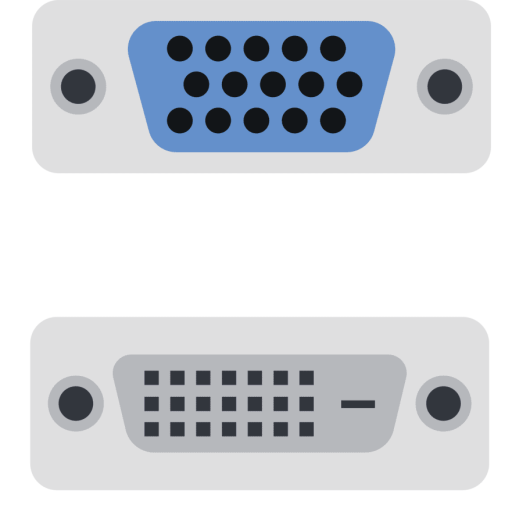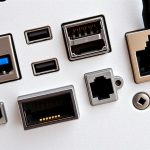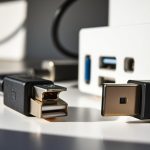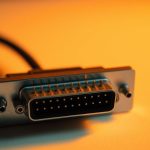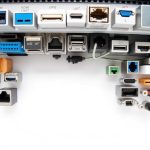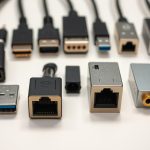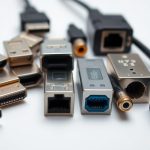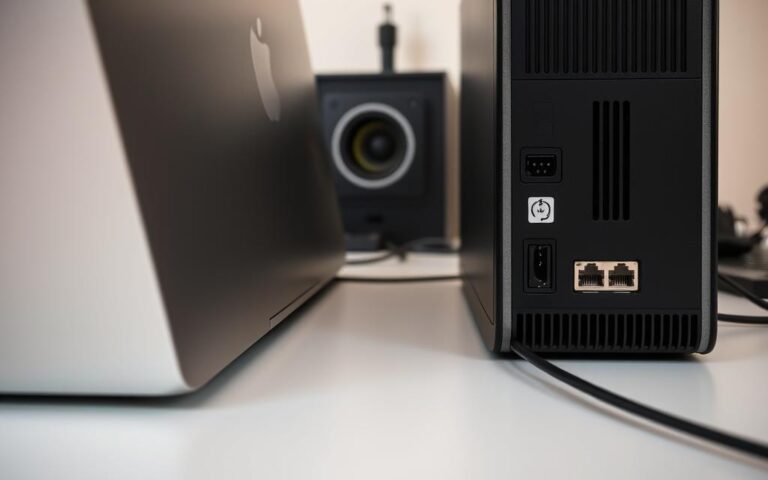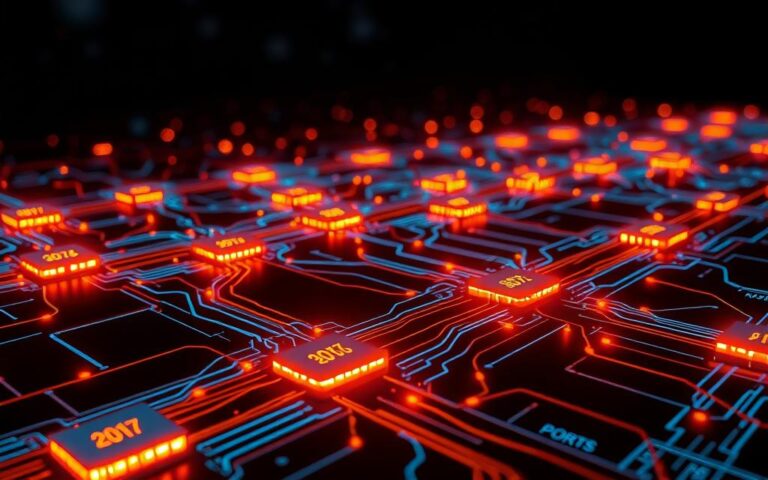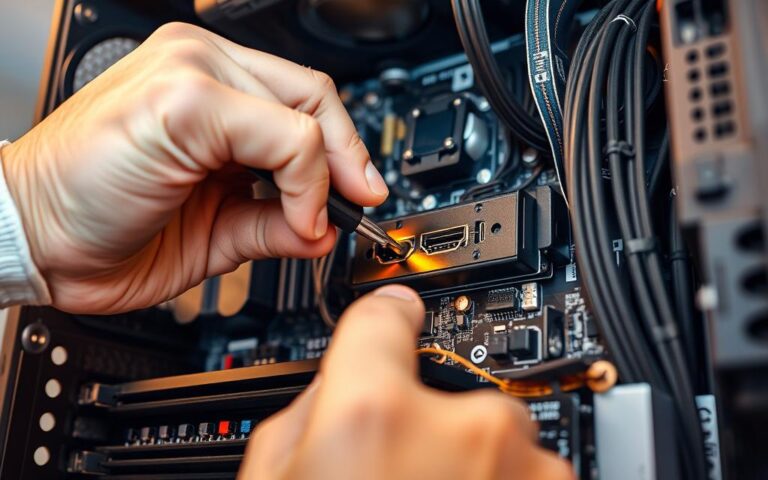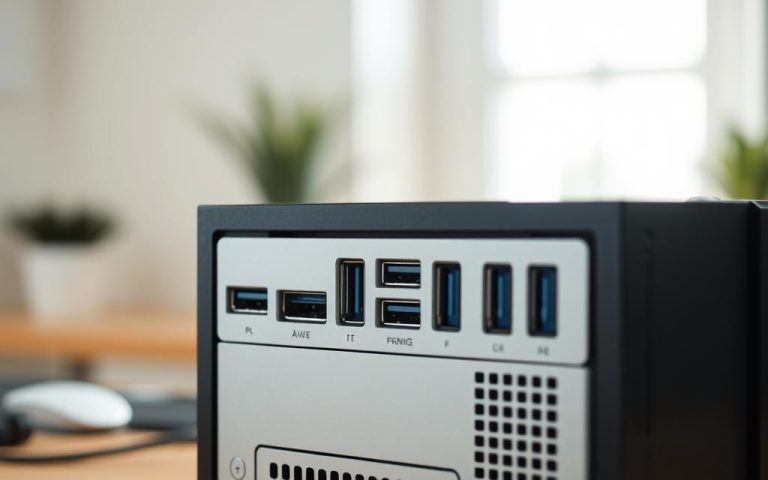USB Ports on PC: Everything You Should Know
Understanding the capabilities and limitations of USB ports on your computer is crucial in today’s digitally driven world. The Universal Serial Bus (USB) has revolutionised the way we connect devices to our PCs, simplifying data transfer and power supply.
Originally designed to standardise the connection of peripherals to personal computers, USB technology has evolved significantly over the years, replacing older interfaces like serial and parallel ports. With various types of USB ports available, identifying the right port for your device can be confusing.
This comprehensive guide will walk you through the basics and advanced aspects of USB ports on your PC, including data transfer speeds, power delivery, and compatibility considerations for various devices.
Understanding USB Technology
The Universal Serial Bus, commonly referred to as USB, has become an indispensable component in modern computing. It has simplified the way devices connect to computers, making it a ubiquitous feature in today’s digital landscape.
USB technology is based on an industry standard developed by the USB Implementers Forum (USB-IF). It is designed for digital data transmission and power delivery between various types of electronics. The Universal Serial Bus specifies the architecture, including physical interfaces and communication protocols, between hosts like personal computers and peripheral devices.
What is USB?
USB stands for Universal Serial Bus, a standardised interface that enables communication between computers and peripheral devices through a common connection. Developed in the mid-1990s by a consortium of companies including Intel, Microsoft, and IBM, USB was designed to simplify and unify the way devices connect to computers.
The universal serial bus technology allows for both data transfer and power delivery through a single cable, eliminating the need for separate power adapters for many devices. One of the most significant advantages of the serial bus standard is its “plug and play” capability, which allows devices to be connected and disconnected without requiring computer restarts.
USB has revolutionised computing by providing a universal connection method that works across different device types, operating systems, and manufacturers. This has made it the most widely adopted connection standard in computing history. The image below illustrates the ubiquity of USB technology in modern devices.
- USB enables communication between computers and peripheral devices through a common connection.
- It allows for both data transfer and power delivery through a single cable.
- The “plug and play” capability simplifies device connection and disconnection.
- USB has become the most widely adopted connection standard across different device types and manufacturers.
In summary, USB technology has transformed the way devices interact with computers, offering a versatile, standardised solution that has become integral to modern computing.
The History of USB Ports
The Universal Serial Bus, commonly known as USB, has a rich history that revolutionized computer connectivity. Introduced in 1996, USB was designed to standardize the connection of peripherals to computers, replacing various interfaces such as serial ports, parallel ports, game ports, and Apple Desktop Bus (ADB) ports.
From Serial and Parallel Ports to USB
Before the advent of the universal serial bus, computers relied on a variety of port types, including serial, parallel, PS/2, and proprietary connections, creating a confusing tangle of cables and compatibility issues. The development of USB began in 1994 when seven companies (Compaq, DEC, IBM, Intel, Microsoft, NEC, and Nortel) formed a consortium to create a simpler, universal connection standard. This initiative aimed to simplify the connectivity of peripherals to computers.
Key Milestones in USB Development
The first USB 1.0 specification was released in January 1996, offering data transfer rates of 1.5 Mbit/s (Low Speed) and 12 Mbit/s (Full Speed). Although widespread adoption didn’t occur until USB 1.1 was released in 1998, this marked the beginning of USB’s journey to becoming a ubiquitous standard. A significant milestone in the serial bus evolution came with USB 2.0 in 2000, which increased maximum data transfer speeds to 480 Mbit/s and helped cement USB as the dominant connection standard.
| USB Version | Release Year | Data Transfer Rate |
|---|---|---|
| USB 1.0 | 1996 | 1.5 Mbit/s (Low Speed), 12 Mbit/s (Full Speed) |
| USB 1.1 | 1998 | 1.5 Mbit/s (Low Speed), 12 Mbit/s (Full Speed) |
| USB 2.0 | 2000 | 480 Mbit/s |
| USB 3.0 | 2008 | 5 Gbit/s |
The universal serial technology continued to evolve with USB 3.0 (2008), USB 3.1 (2013), USB 3.2 (2017), and USB4 (2019), each bringing substantial improvements in speed, power delivery, and functionality. Today, USB remains a crucial component in modern computing, supporting a wide range of devices such as keyboards, mice, cameras, printers, scanners, flash drives, smartphones, game consoles, and power banks.
Types of USB Ports on PC
The universal serial bus (USB) technology has evolved to include several types of ports on PCs, catering to the diverse needs of users and the variety of devices available. Understanding the different types of USB ports is essential for making informed decisions about which peripherals to use with your computer.
USB Type-A Ports
USB Type-A ports are the most recognisable and common type found on computers. They feature a rectangular shape and are designed to connect peripherals like keyboards, mice, and storage devices to your PC. The versatility of USB Type-A ports has made them a staple in the industry, with many devices still relying on this traditional connector.
USB Type-B Ports
USB Type-B ports are typically found on larger peripheral devices such as printers and scanners. They have a square shape with slightly bevelled corners on the top to ensure correct orientation. While not as ubiquitous as Type-A ports, Type-B ports remain an important interface for certain devices that require a more robust connection.
USB Type-C Ports
The newer USB Type-C ports represent a significant advancement in the universal serial bus standard. Featuring a small, reversible connector, USB Type-C can transmit data, video signals, and deliver up to 240W of power. This versatility makes USB Type-C an attractive option for both data transfer and power delivery, potentially replacing the need for multiple port types on future devices.
Mini and Micro USB Ports
Mini and Micro USB ports were developed for smaller devices like digital cameras and mobile phones. Micro USB, in particular, became the standard charging port for most Android devices before the advent of USB-C. Although their usage has declined with the rise of USB Type-C, they remain relevant for certain legacy devices and peripherals.
In conclusion, modern computers often feature a mix of these port types, with newer models increasingly adopting the USB-C connector as the primary interface due to its versatility and the serial bus capabilities it supports. As technology continues to evolve, understanding the different types of USB ports will remain crucial for maximizing the utility of your PC and peripherals.
USB Standards and Speeds
The Universal Serial Bus (USB) has undergone significant transformations since its inception, with various standards emerging to cater to the evolving needs of device connectivity. Understanding these standards is crucial for maximising the potential of your devices and ensuring compatibility.
USB1.x (Low and Full Speed)
USB1.x introduced the first universal serial bus standards, offering Low Speed (1.5 Mbit/s) and Full Speed (12 Mbit/s) data rates. These speeds were suitable for basic peripherals like keyboards and mice. Although largely outdated, USB1.x laid the groundwork for subsequent advancements.
USB2.0 (High Speed)
Released in 2000, USB2.0 significantly increased the transfer rate to 480 Mbit/s (60 MB/s theoretical maximum). This enhancement enabled the connection of more data-intensive devices like webcams and external hard drives, expanding the utility of USB ports.
USB3.x Family (SuperSpeed)
The USB3.0 standard, introduced in 2008, revolutionised the serial bus with SuperSpeed technology, offering 5 Gbit/s (625 MB/s theoretical) data rates. Recognisable by the blue colour inside the ports, USB3.0 marked a substantial leap forward. Subsequent iterations, including USB3.1 Gen2 (SuperSpeed+) and USB3.2, further doubled and then quadrupled the data rates to 10 Gbit/s and 20 Gbit/s, respectively, when using compatible devices and cables.
| USB Standard | Data Transfer Rate | Notable Features |
|---|---|---|
| USB1.x | 1.5 Mbit/s (Low Speed), 12 Mbit/s (Full Speed) | Basic peripherals support |
| USB2.0 | 480 Mbit/s | Higher data transfer rate for devices like webcams |
| USB3.0 | 5 Gbit/s | SuperSpeed technology, blue port inserts |
| USB3.1 Gen2 | 10 Gbit/s | SuperSpeed+, enhanced data rates |
| USB3.2 | Up to 20 Gbit/s | Multi-lane operations for higher speeds |
USB4 Technology
The latest USB4 technology, based on the Thunderbolt 3 protocol, supports 40 Gbit/s throughput. It is backward compatible with USB3.2 and USB2.0, and allows dynamic bandwidth allocation between data and video. This represents a significant step forward in USB technology, offering both high-speed data transfer and versatile connectivity options.
Port USB PC Identification
USB ports on your PC come in different shapes and sizes, and understanding their capabilities is essential for optimal use. With the variety of USB standards available, correctly identifying the ports on your computer is crucial for ensuring you’re using the right connection for your devices.
Visual Identification of USB Ports
Visual identification of USB ports on your computer can be done by examining the physical shape of the connector. Type-A ports are rectangular, Type-B ports are square, and Type-C ports are oval and symmetrical. This visual distinction helps in identifying the type of USB port you’re dealing with.
USB Port Colour Coding
The Universal Serial Bus standard uses colour coding to help identify port capabilities. Typically, white or black indicates USB2.0, blue denotes USB3.0, and teal/turquoise signifies USB3.1. Red or yellow often denotes ports with enhanced charging capabilities. However, it’s worth noting that these colours are not consistent across all equipment manufacturers.
Finding USB Information in Windows
To find detailed information about the USB ports on your Windows PC, you can use the Device Manager. Simply right-click on the Start button, select “Device Manager,” and expand the “Universal Serial Bus controllers” section. This will provide you with a list of all the USB ports on your computer, along with their specifications.
By understanding the different types of USB ports and their capabilities, you can ensure that you’re using the right port for your specific device needs, thereby taking advantage of the fastest available transfer speeds.
How USB Ports Work
The functionality of USB ports is rooted in their architecture and protocol. USB ports operate on a host-controlled architecture where the computer (host) initiates all data transfers and manages communication with connected devices through a standardised universal serial bus protocol.
USB Architecture and Protocol
The USB architecture is designed to facilitate efficient data transfer and device management. At its core, the universal serial bus uses a tiered star topology, allowing a single host controller to connect to multiple devices either directly or through hubs. This design enables expansion beyond the physical ports available on a computer.
When a device is connected to a USB port, a process called enumeration occurs. During enumeration, the host identifies the device, loads the appropriate drivers, and establishes communication parameters before data transfer can begin. This process ensures that devices are properly configured and ready for use.
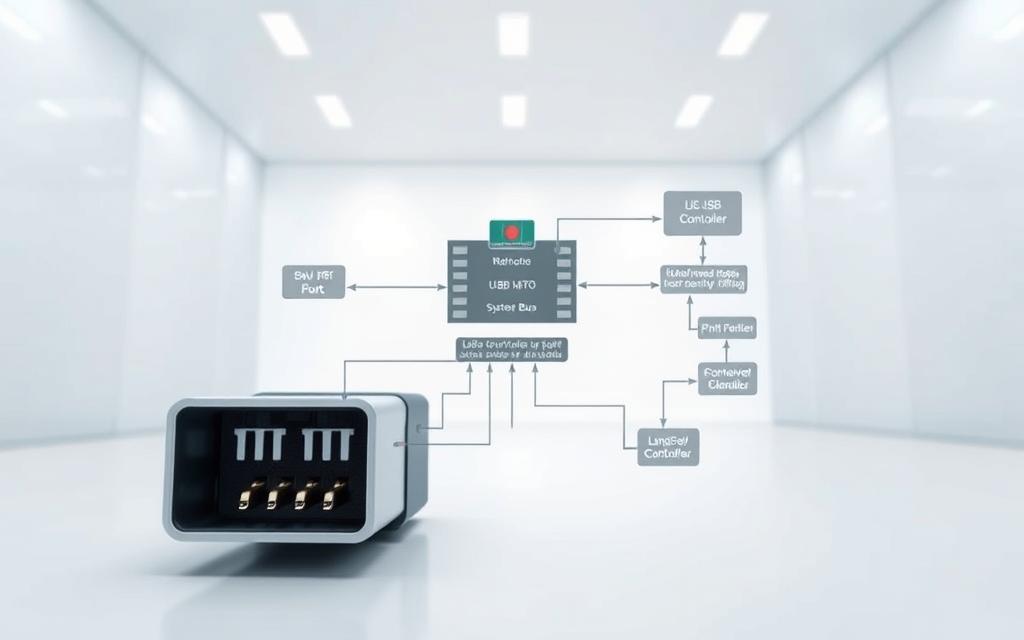
Host Controllers and Root Hubs
At the heart of USB operation are host controllers and root hubs. Host controllers manage the physical connections and data transfers between the computer and peripheral devices. The root hub is an integral part of the host controller, providing a connection point for devices and additional hubs. Together, they enable the efficient management of multiple devices connected to the computer.
| Component | Function |
|---|---|
| Host Controller | Manages data transfers and device connections |
| Root Hub | Provides connection points for devices and additional hubs |
Power Management in USB Ports
Power management in USB ports is sophisticated, with the ability to provide standard power (up to 500mA for USB 2.0, 900mA for USB 3.0) or, with USB Power Delivery, up to 240W for compatible devices. This flexibility allows a wide range of devices to be powered directly from the USB interface, eliminating the need for additional power supply cables.
The advanced power management capabilities of USB ports make them highly versatile and convenient for users. By understanding how USB ports work, users can better utilise their devices and troubleshoot any issues that may arise.
USB Port Capabilities
Modern USB ports boast impressive capabilities, including high-speed data transfer, power delivery, and support for video and audio transmission. These advanced features have made USB ports an essential component of modern computing, simplifying connectivity and enhancing user experience.
Data Transfer Capabilities
USB ports offer impressive data transfer capabilities, with speeds varying by standard. For instance, USB2.0 supports up to 480 Mbps, while USB4 can reach speeds of up to 40 Gbps. This enables everything from simple file transfers to complex data streaming applications. The high-speed data transfer capabilities of modern USB ports make them ideal for demanding applications.
- USB2.0: Up to 480 Mbps
- USB3.x: Up to 5 Gbps (SuperSpeed) or 10 Gbps (SuperSpeed+)
- USB4: Up to 40 Gbps
Power Delivery Features
The universal serial bus power delivery features have evolved dramatically, with USB-C ports now capable of delivering up to 240W of power. This is enough to charge laptops, power external displays, and fast-charge mobile devices. The USB Power Delivery (PD) specification ensures that devices can negotiate the appropriate power levels, making it a versatile and efficient charging solution.
Video and Audio Transmission
Contemporary USB ports support video and audio transmission through Alternate Mode (Alt Mode) protocols. This allows DisplayPort, HDMI, or Thunderbolt signals to be carried over the same serial bus connection. The ability to transmit video and audio signals over USB makes it possible to connect devices to external monitors or displays without the need for separate video cables.
In summary, the capabilities of modern USB ports make them a versatile and essential component of modern computing. With their high-speed data transfer, power delivery, and multimedia transmission capabilities, USB ports simplify connectivity and enhance user experience.
Common USB Port Issues
The universal serial bus (USB) technology, while widely used, is not immune to certain problems. Users often encounter issues that can range from simple connectivity problems to more complex hardware or software conflicts. Understanding these common issues can help in troubleshooting and resolving them effectively.
Unresponsive USB Ports
Unresponsive USB ports are among the most frustrating issues users face. This problem can occur when a USB device is inserted and removed repeatedly in quick succession, potentially causing a timing issue that prevents the computer from detecting the USB device. Other causes include driver conflicts, power management settings, or physical damage to the port or connected device. Ensuring that drivers are up-to-date and checking power management settings can often resolve this issue.
- Check for physical damage to the USB port or device.
- Update USB drivers to the latest version.
- Adjust power management settings to prevent the USB port from being turned off.
Device Not Recognised Problems
“Device not recognised” problems typically occur when the universal serial bus controller cannot properly identify a connected device. This can be due to outdated drivers, incompatible hardware, or corrupted USB device descriptors. Resolving this issue often involves updating drivers, checking for hardware compatibility, or reinstalling the device.
- Update the USB driver to the latest version.
- Check the device’s compatibility with the computer’s USB version.
- Reinstall the USB device to resolve any software conflicts.
Power-Related USB Issues
Power-related issues with USB connections can include insufficient power delivery for high-demand devices, voltage fluctuations affecting device performance, and problems with the serial bus power management system. The USB device may not function correctly if it requires more power than the port can supply. Using a powered USB hub can help alleviate these issues by providing additional power to connected devices.
Troubleshooting USB Port Problems
Diagnosing USB port issues effectively involves understanding the potential causes and using the right diagnostic tools. USB port problems can manifest in various ways, such as unresponsive ports, devices not being recognised, or intermittent connectivity issues.
Using Device Manager to Diagnose Issues
The Device Manager is a crucial tool for diagnosing USB port problems. It allows users to identify issues with Universal Serial Bus (USB) controllers, check for error codes, and manage driver installations. To diagnose issues, open Device Manager, scan for hardware changes, and look for any devices with error indicators. Updating drivers or disabling and re-enabling USB controllers can often resolve connectivity issues.
When troubleshooting, it’s also beneficial to check the USB device itself and try different ports or cables to isolate the problem.
Updating USB Drivers
Updating USB drivers is often an effective solution for resolving port issues. This can be done through Device Manager by right-clicking on the problematic device or controller and selecting “Update driver.” Ensuring that USB drivers are up-to-date can prevent a range of issues, from device non-recognition to intermittent connectivity problems. Regularly checking for driver updates is a good maintenance practice.
Hardware Solutions for USB Problems
For persistent USB port issues, hardware solutions may be necessary. This can include using different USB ports, testing with alternative cables, or connecting devices through powered hubs to address power-related issues. Physically cleaning dust or debris from USB ports can also resolve connectivity problems. In some cases, adjusting power management settings or disabling the “Selective Suspend” feature may be required to maintain USB functionality.
Advanced USB Features
The latest USB technology has introduced several advanced features that enhance user experience. These features are designed to improve the functionality and versatility of USB ports, making them more useful for a wide range of applications.
USB On-The-Go (OTG)
USB On-The-Go (OTG) is an advanced feature that allows compatible mobile devices to function as hosts, enabling them to connect directly to USB peripherals like keyboards, mice, or storage devices without requiring a computer intermediary. This feature is particularly useful for expanding the capabilities of mobile devices. For more information on USB connectivity types and standards, visit TripLite’s USB Connectivity Guide.
USB Alternate Modes
Alternate Modes represent a significant evolution in USB functionality, allowing the serial bus to carry non-USB protocols such as DisplayPort, HDMI, or Thunderbolt over USB-C connections, effectively turning a USB port into a multi-purpose interface. With DisplayPort Alt Mode, USB-C connectors and cables have the ability to transmit both USB data and VGA, DVI, HDMI or DisplayPort video and/or audio. This capability enhances the utility of USB ports, making them more versatile.
| Feature | Description | Benefits |
|---|---|---|
| USB On-The-Go | Allows mobile devices to act as hosts | Expands mobile device capabilities |
| Alternate Modes | Enables non-USB protocols over USB-C | Enhances USB port versatility |
| USB Power Delivery | Fast charging protocol up to 240W | Safe and efficient power transfer |
USB Power Delivery
USB Power Delivery is a sophisticated charging protocol that enables fast charging up to 240W while intelligently negotiating power requirements between devices, ensuring optimal and safe power transfer. This feature is particularly useful for charging larger devices like laptops. These advanced features are primarily available on USB3.0, USB3.1, and newer hardware, with full functionality typically requiring USB-C connectors rather than the older USB-A or USB-B formats.
Understanding these capabilities allows users to maximise the potential of their USB devices, potentially reducing the need for multiple cables and adapters while enhancing connectivity options.
Expanding USB Connectivity
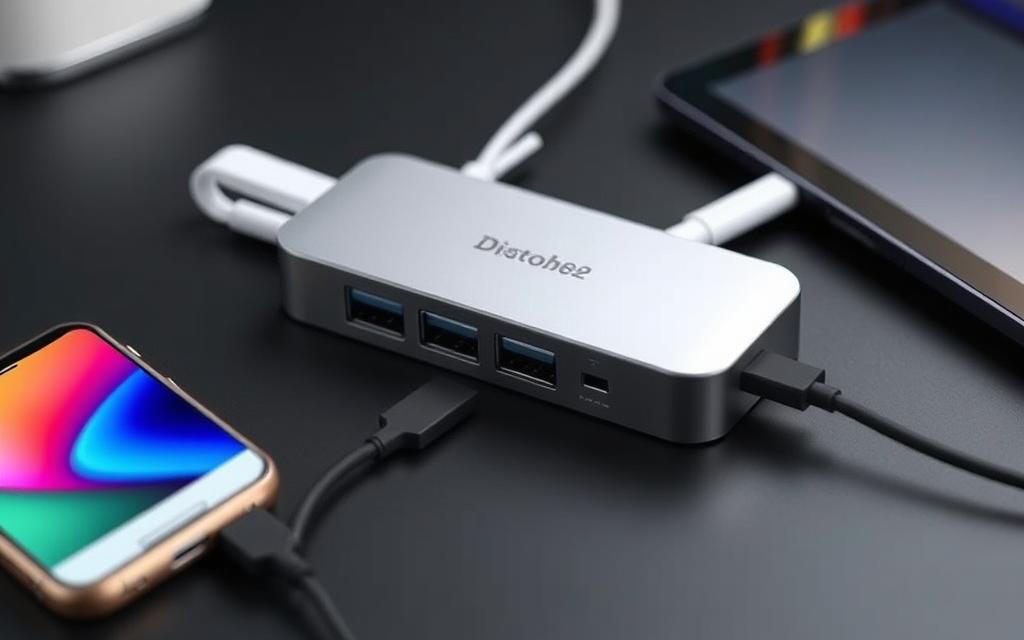
The need to connect multiple devices to a PC has led to the development of various USB expansion solutions. As the number of peripherals and accessories grows, so does the demand for more USB ports. This has resulted in the creation of USB hubs, docking stations, and extension cables, designed to expand the connectivity options of a computer.
USB Hubs and Switches
USB hubs provide an efficient solution for expanding the number of available ports on your computer. They come in various designs, with some offering additional power for devices that require more electricity than a standard USB port can supply. Powered hubs are particularly useful for connecting high-power devices such as external hard drives.
USB Docking Stations
Docking stations represent a comprehensive expansion option, typically offering multiple USB ports alongside other connectivity options like HDMI, DisplayPort, Ethernet, and audio connections. They are ideal for laptop users who need desktop-like connectivity. Some docking stations support advanced features such as playing true 4K high-resolution video and digital audio on two large displays simultaneously.
USB Extension Cables and Adapters
USB extension cables and adapters can solve specific connectivity challenges. However, users should be aware of the limitations. For instance, USB2.0 extensions should not exceed 5 metres, and USB3.0/3.1 extensions should be kept under 3 metres to avoid signal degradation. For optimal performance with high-bandwidth devices, it’s advisable to select expansion options that support the latest USB standards.
USB Port Management in Windows
Windows provides several tools for managing USB ports, enhancing user control over device connectivity. Effective management of USB ports is crucial for optimising device performance, troubleshooting issues, and conserving power.
Viewing USB Devices in Device Manager
Device Manager is a comprehensive tool for viewing and managing USB devices connected to your computer. To access it, press the Windows key + X and select Device Manager. In the Device Manager window, you can view all connected USB devices, check their status, and access detailed information about their capabilities and drivers. This information is vital for troubleshooting device issues and ensuring that devices are functioning correctly.
USB Selective Suspend Settings
The USB Selective Suspend feature is designed to conserve power by allowing Windows to put individual USB ports into a low-power state when not in use. However, this feature can sometimes cause devices to become unresponsive. To manage Selective Suspend settings, you can access Power Options in Control Panel, navigate to the advanced power settings, and modify the “USB settings” section to disable this feature if it’s causing problems with your devices.
For more granular control, you can adjust power management options for individual USB root hubs in Device Manager. By right-clicking each controller, selecting Properties, and unchecking “Allow the computer to turn off this device to save power” on the Power Management tab, you can prevent Windows from suspending specific USB devices.
USB Power Management Options
USB Power Management Options provide further control over how Windows handles power for connected USB devices. By accessing the Properties of each USB Root Hub in Device Manager, you can configure whether the computer can turn off the device to save power. This setting is particularly useful for ensuring that critical devices remain operational.
| USB Device Type | Power Management Option | Effect on Device |
|---|---|---|
| USB Storage Devices | Allow computer to turn off this device | Device may be suspended when not in use |
| USB Input Devices | Do not allow computer to turn off this device | Device remains powered and responsive |
USB Ports vs. Other Connection Types
Understanding the differences between USB and other connection types is crucial for selecting the right hardware for your needs. As technology advances, various connection standards have emerged, each catering to specific requirements and applications.
USB vs. Thunderbolt
While USB and Thunderbolt connections may appear identical when using USB-C connectors, they serve different purposes and offer distinct performance characteristics. Thunderbolt technology, developed by Intel in collaboration with Apple, provides significantly higher bandwidth, reaching speeds of up to 40 Gbps, making it ideal for demanding applications such as external GPUs and multi-display setups.
Key differences between USB and Thunderbolt include:
- Higher bandwidth for Thunderbolt, making it more suitable for high-performance applications
- USB’s wider compatibility with a broader range of devices
- Thunderbolt’s ability to support multiple 4K displays or a single 5K display
USB vs. HDMI and DisplayPort
When comparing USB to dedicated video connections like HDMI and DisplayPort, it’s essential to consider their respective capabilities. USB3.1 with Alternate Mode (Alt Mode) can support video transmission, but it may not match the maximum resolutions or refresh rates offered by dedicated video ports.
The main differences are:
- Dedicated video ports generally offer higher resolutions and refresh rates
- USB’s versatility in handling data, power, and potentially video over a single connection
- The convenience of using a single USB-C port for multiple purposes
When to Choose USB Over Other Connections
USB connections excel in versatility and are ideal when you need a single connection that can handle data transfer, power delivery, and potentially video transmission. The latest USB standards, such as USB4, incorporate Thunderbolt 3 protocol support, narrowing the gap between previously distinct hardware interfaces.
Choose USB when:
- You require a universal connection that can handle multiple tasks
- You need compatibility with a wide range of devices
- You prioritise convenience and simplicity in your connectivity options
In conclusion, the choice between USB and other connection types depends on your specific needs and the devices you’re using. By understanding the strengths and limitations of each connection standard, you can make informed decisions about your hardware setup.
USB Security Considerations
USB devices, while convenient, pose significant security challenges that users must be aware of. The use of USB devices can potentially introduce malware, act as keystroke loggers, or emulate other hardware types to compromise a computer’s security.
USB Data Security Risks
One of the significant risks associated with USB devices is their potential to carry malware or be used for “BadUSB” attacks. These attacks involve malicious firmware that can reprogram a USB device to act as a keyboard, network card, or other hardware, bypassing traditional security measures.
- Malware introduction through USB devices
- “BadUSB” attacks that reprogram USB devices for malicious purposes
- Emulation of other hardware types to compromise security
Protecting Your PC from USB Threats
To protect against these threats, users should implement several security measures. These include using only trusted USB devices, enabling USB port security features in the operating system, and keeping antivirus software updated.
- Using trusted USB devices only
- Enabling USB port security features
- Keeping antivirus software updated
- Using hardware solutions like USB port blockers for organisations
- Being cautious with unknown USB devices and public USB ports
Future of USB Technology
The next generation of USB technology is poised to deliver unprecedented speeds and capabilities, redefining the computing landscape. As we look to the future, it’s clear that USB will continue to play a vital role in shaping how we interact with devices.
Upcoming USB Standards
The future of USB technology is centred around the USB4 standard, which promises data transfer rates up to 80 Gbps with USB4 2.0, twice the speed of the original USB4 specification and eight times faster than USB3.1. Some key features of upcoming USB standards include:
- Consolidation of various connection types, with the USB-C connector becoming the universal standard
- Enhanced power delivery capabilities, with USB-PD expected to support up to 240W
- Improved intelligent power management and enhanced security features
The USB4 specification also supports Thunderbolt 3 protocols, including PCI Express (PCIe) and DisplayPort, and adds host-to-host interfaces. This convergence of technologies will simplify the user experience while delivering higher performance for demanding applications.
How USB Will Shape Future Computing
As USB technology evolves, we can expect to see greater convergence with other standards like Thunderbolt, creating a more unified connectivity ecosystem. This will have a significant impact on future computing, enabling faster data transfer, improved power delivery, and enhanced functionality.
| USB Standard | Transfer Rate | Power Delivery |
|---|---|---|
| USB2.0 | 480 Mbps | 2.5W |
| USB3.1 | 10 Gbps | 100W |
| USB4 | 40 Gbps | 240W |
| USB4 2.0 | 80 Gbps | 240W |
The future of USB technology is exciting, with significant advancements on the horizon. As the industry continues to adopt these new standards, we can expect to see improved performance, enhanced functionality, and a more streamlined user experience.
Conclusion
In conclusion, understanding USB ports is crucial for maximizing the potential of your computer and connected devices. Throughout this comprehensive article, we’ve explored the evolution, types, capabilities, and troubleshooting methods for USB ports on your PC.
The USB technology has transformed significantly, from a simple peripheral connection to a universal standard that handles data, video, audio, and power delivery. This versatility makes it the most widely-used connection type in modern computing.
As USB technology continues to advance with faster transfer speeds and enhanced capabilities, users can expect even greater convenience and functionality from their connected USB devices. Understanding how to properly identify, use, and troubleshoot USB ports ensures you’ll get the maximum performance and reliability from your devices.
Whether you’re connecting simple peripherals or leveraging advanced features like video output and fast charging, the knowledge gained from this guide will help you make the most of the USB ports on your PC. By grasping the fundamentals of USB technology, you’ll be well-equipped to navigate the ever-evolving landscape of computer connectivity.
In the latest USB standard, the USB-C connector replaces many types of connectors for power, displays, and other uses, further solidifying USB‘s position as a leading connection standard. As you move forward, you’ll be able to harness the full potential of your connected USB devices, enjoying enhanced functionality and performance.
FAQ
What is the difference between USB2.0 and USB3.0?
USB3.0 offers significantly faster data transfer rates compared to USB2.0, with speeds of up to 5 Gbps, whereas USB2.0 has a maximum speed of 480 Mbps.
How do I identify the type of USB controller on my computer?
You can check the type of USB controller by opening the Device Manager on your Windows system and looking under the “Universal Serial Bus controllers” section.
Can I use a USB3.0 device with a USB2.0 host controller?
Yes, USB3.0 devices are backward compatible with USB2.0 host controllers, but they will operate at the slower USB2.0 speeds.
What is the purpose of a root hub in USB architecture?
The root hub is a crucial component that manages multiple USB ports on a computer, allowing multiple devices to be connected and controlled.
How do I troubleshoot an unresponsive USB device?
Try reconnecting the device, restarting your computer, or checking the Device Manager for any issues related to the device or its driver.
What is USB Power Delivery?
USB Power Delivery is a specification that allows for higher power delivery over USB, enabling faster charging and powering of larger devices.
Can I connect multiple USB devices to a single USB hub?
Yes, USB hubs allow you to expand a single USB port into multiple ports, enabling the connection of multiple devices.
What are the benefits of using USB Type-C?
USB Type-C offers faster speeds, higher power delivery, and a reversible design, making it a versatile and convenient connection option.
How do I update my USB drivers?
You can update your USB drivers by going to the Device Manager, finding the USB device or controller, right-clicking on it, and selecting “Update driver”.
